ORDER
Anseriformes
FAMILY
Anhimidae
GENUS & SPECIES
KEY FEATURES
• Named for their noisy, high-pitched call, which can be heard over 1.5 miles away
• Gregarious screamers spend long periods perching conspicuously in trees like birds of prey, but feed on succulent aquatic plants like their waterfowl relatives
• Use unusual wing spurs during territorial and mating battles
WHERE IN THE WORLD?
Found in South America from Colombia south to Argentina; northern screamers are found only in Colombia and Venezuela; southern screamers in Bolivia, Brazil and Argentina
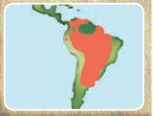
Lifecycle
Screamers attract attention: they perch conspicuously on treetops, utter a noisy, high-pitched call and congregate in large flocks, often numbering in the thousands.
Habitat
Screamers are typically found in South American swamplands, but also frequent wooded zones where they perch on trees. Horned and southern screamers favor open plains and grassy meadows near water. The northern screamer prefers marshes with dense vegetation north of the equator (hence its common name), and lives well over 1,000 miles from the southern screamer. The horned screamer’s range lies between the two others’ and overlaps their ranges slightly.
See and be seen A treetop perch gives two southern screamers a great view of the marsh.
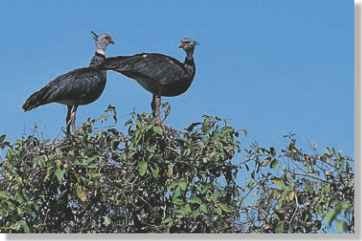
Screamers are especially unpopular among hunters, since their alarm call immediately warns all other animals of human presence — making it difficult for hunters to take their intended prey by surprise.
Both sexes produce a threatening gruff noise, which sounds like drumming or cracking. It appears that this sound may be produced not vocally but by the sudden collapse of subcutaneous air sacs that are found beneath the skin.
conservation
None of the three species of screamer is globally threatened, but habitat destruction is definitely the main threat to all species. Rainforest clearing, wetland drainage and water quality deterioration (due to the use of pesticides and insecticides) are all affecting numbers. Extensive work is required to help determine current numbers and conservation requirements.
Breeding
Since they inhabit warm, tropical regions, screamers may breed at any time of the year: Pairs usually mate for life, and courtship during pair formation includes repeated calls, mutual preening and walking side by side.The horned screamer is the most territorial of the three species of screamer: The male uses his moohooka call to define the territorial borders and defend his position and mate. If an intruder is persistent, any of the species will engage in battle by pecking, kicking, flapping their wings and slashing with their wing spurs. Parts of the horny spur coverings have been found embedded in the breasts of other screamers.
The two parents are true partners. They both build the nest, which is made of weeds, reeds and sticks, and placed either in shallow water or on dry ground not far from water After the female lays the 2-7 large, spotted eggs, the parents take turns incubating. After 40-47 days, the chicks hatch with thick, grayish-yellow down.They are able to leave the nest within a few days and accom-pany their parents during grazing, though the growing young also eat protein-rich insects to supplement their diet.They fledge within 8-10 weeks, but don’t become fully independent until about 14 weeks of age. Juveniles will remain in large flocks, even during the breeding season, until they become sexually mature — usually not before 2 years of age.
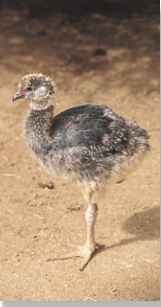
Slightly southern A southern screamer chick starts to develop its distinguishing neck ring.
a team of screamers
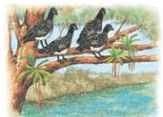
Four horned friends…
A small group of horned screamers, named for unique “horn” feathers, survey a marshy wetland, preparing to head out on a foraging trip.

Ready to defend.
The wing’s sharp spurs can be used for defense against predators when the birds are out in search of feeding grounds.
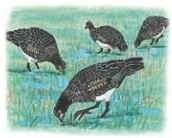
Hunt and peck together…
The screamers peck at the fleshy parts of the vegetation while treading across the wetland with their lightweight, unwebbed feet.
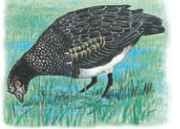
In all kinds of weather
The screamer eats leaves, stems and roots, always looking for the succulent parts, and remains a vegetarian throughout the year.
Behavior
Screamers are year-round residents of South American marshes, and their presence is hard to miss. All three species spend long periods of time perched on the tops of trees, their 3′-long bodies highly visible from near or far This behavior may seem odd for an aquatic bird, but their long-toed, unwebbed feet are perfect for perching — whether to rest, escape predators or oversee a territory.
The screamers’ noisy, high-pitched call, which often sounds like a trumpet, is the most obvious sign of the screamers’ presence. The call is often repeated for hours on end and can be heard up to 1.5 miles away. One screamer’s call generally starts a chorus, either in flight or at their nighttime roosting site, and the combined voices
are often deafening. The birds are very gregarious: They sing together graze in groups, and fly in large flocks that can number in the thousands.
Sidekicks Two northern screamers stretch their legs and toes during a long foraging trip.
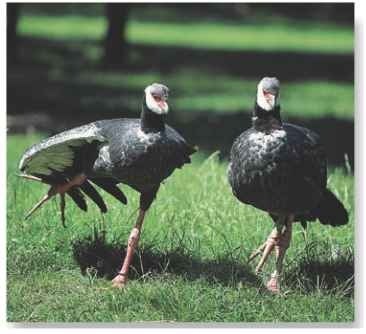
Food & feeding
All three species of screamer graze amid aquatic vegetation, but they have a preference for fleshy leaves, stems and roots. Though they often walk half-submerged in their swampland haunts, the birds also stride lightly across thick, floating vegetation in their quest for succulent plants. Occasionally they find their way to crop fields,where they join other birds and add seeds as well as vegetables to their menu. Screamers graze in flocks outside of the breeding season, where they may be seen digging in the mud for buried aquatic plants.
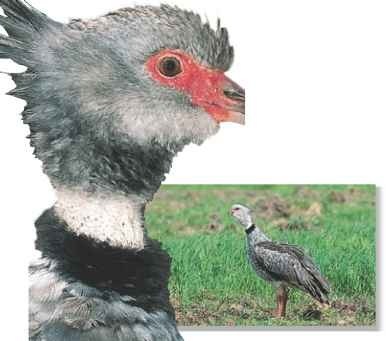
Profile
Screamers
Screamers have unwebbed feet, spurs on their _wings and chickenlike heads and bills, but they are close relatives of ducks, geese and swans.
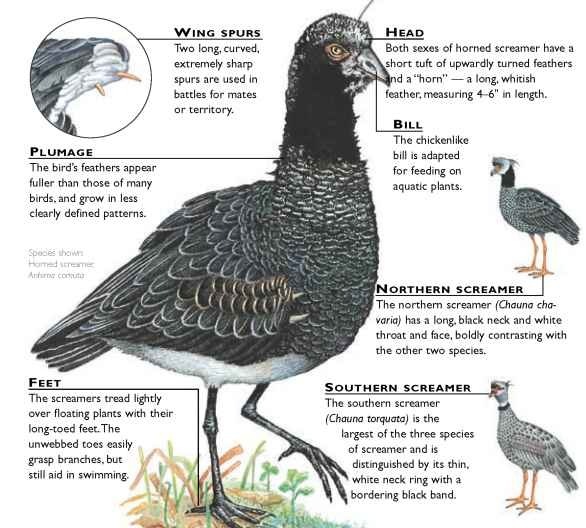
Creature comparisons
Measuring 32″ in length, the magpie goose (Anseranas semipalmata) of Australia and New Guinea is slightly smaller than the horned screamer With its long neck and bill, the magpie looks like its geese relatives, but it is a poor swimmer, and its partially webbed feet and perching habits are similar to the horned screamer’s. Both birds molt their feathers gradually, so they do not go through a 4-8-week period of flightlessness — an interval of vulnerability for all other geese, ducks and swans.
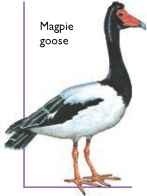
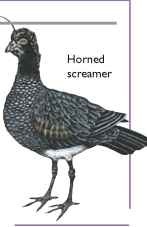
| VITAL Weight Length |
STATISTICS 6.5-9.5 lbs. 32-36″ |
| Wingspan | Over 5.5′ |
| Sexual Maturity | Usually more than 2 years |
| Breeding Season | Year-round |
| Number of Eggs | 2-7 |
| Incubation Period | 40-47 days |
| Fledging Period | 8-10 weeks |
| Breeding Interval | Up to 1 year |
| Typical Diet | Leaves, stems, flowers and roots of aquatic plants |
| Lifespan | Unknown |
RELATED SPECIES
• The Anhimidae famly contains 3 species of screamer in 2 genera: Anhima and Chauna. The order Anseriformes also includes 147 species of duck, goose and swan. The screamers all have head adornments, but the male comb duck, Sarkidiornis melanotos melanotos, has a huge knob over his bill. Like screamers, the spur-winged goose, Plectropterus gambensis, has spurs on its wings.

